to shield or not to shield
Printed From: the12volt.comForum Name: Car Audio
Forum Discription: Car Stereos, Amplifiers, Crossovers, Processors, Speakers, Subwoofers, etc.
URL: https://www.the12volt.com/installbay/forum_posts.asp?tid=133833
Printed Date: December 17, 2025 at 5:38 AM
Topic: to shield or not to shield
Posted By: myonus
Subject: to shield or not to shield
Date Posted: March 10, 2013 at 10:51 PM
That is the question.
This topic is going to take a little explaining; but I know how much everyone loves my story telling, just kick back relax and sit a spell; Im gonna take you on a journey!
6 months and $600.00 ago
I found this darling little mp3 player on sale at Parts Express. Nifty used thumb drive/ SD memory and had a remote. Works off 5v. and a line level stereo ouput. Now how was I gonna get that in my car. They were only $8 or somthing, so I bought 2 of them. They are fantastic; except for a couple tiny manufacture flaws (no support what so ever, and a remote that has more functions than it says it does. Including a software library that I have yet to figure out. , amazing none the less.
So, coincedentally iSimple makes a aux input for my car, and the OEM radio I have has a premium CD changer you can get, yet I dont. The iSimple device lies (more like teases) the radio and computer to think that it has a compliant OEM CD changer on board, and i just turn on the mp3 player now installed on my dash. Perfect. Especilly the remote feature. I dont even have to lift my arm to change songs. And I hve a ton f old SD memory cards from cameras. and a new 32 gb that has all my mp3's and i can jam out for....like .....forever man!
I built a harness that converts the 3 wire output to dual RCA using a wiring i borrowed from the equipment I use at the studio. Ballanced TRS. You have a hot and ground, and a 3rd wire that surrounds and shields the two active wires from noise. I did not borrow the imnpediance leveling however as that would require a transformer a couple caps and stuff that really? i dont need that. The isimple isnt even a low level input. and neither is the radio. But the technique just the same was easy enough, maybe i could prevent any hum or signal decay. well it sounds great. no problems except one. This device was not made for a car. and when i use a thumb drive, it makes some nasty noise and clearly not the way to go. The SD memory cards are pin drop silent, and i have no problem just stickin with that.
The mp3 palyer dosnt have a case, open PCB and open microprocessors, usb plug/ memory slots bare, and the back is a haven for anything to get in there and cause mischief.
So how can I shield this accessory that does contribute to the sound sytem, yet it donent actually eat much of any resources. I dant have it fused yet, i need to do that. I have it hooked up to a switch, but it makes a hell of a pop when i turn it on, so i turn it on before i turn on the car, then its allready made its pop, and i dont have to endure it through my system.
On my guitars if I experience noise depending on the guitar itself i may go as far as to add foil shielding and a ground plate this seems to help when dealing with passive magnetic humbuckers. But may have no effect on this player. I could use a little magnet that is wound around a inch or so of USB cable. I used a USB cabel because coincedentially its 5volts. and the USB cabel was for a video camera that had one on it, so i left it. when i hook it up to the input uf the computer, no noise what so ever, frigin genius.
So anyways thats ther story of the little MP3 player that just wants to be part of the cool gang down at the playground.
Somewhere i heard there is no such thing as sheilding. what you are really expperiencing is a complex filter. The interference is still there, and still penetrates the device, its just masked by a series of filters, so you dont hear it. Kinda like that not - so - fresh feeling that everyone else notices; but you just seem to be amune to the noise.
Thanks for any assistance or guidentce, i know this is a unique idea, so maybe this will also inspire others to seek. I want to make a old school VU meter for my sub box. and a volt meter alarm for the battery and system load. And strategic areas of lighting where comon mainainence points are. How are these non sound devices worked into the design of a system, and how do I manage resouces and prevent system failure.
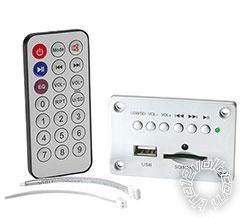
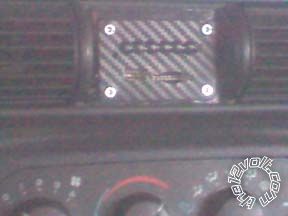
-------------
Be not guided by morality, but rather, integrity.
Replies:
Posted By: oldspark
Date Posted: March 10, 2013 at 11:26 PM
But follow normal shielding procedures - eg, a shield that is only tied to one end etc.
Or add caps depending on what the noise is. (You didn't say if the player is battery or car powered.)
And maybe it is a impedance matching issue, especially if the unit has an audio out (headphones etc) rather than a line out.
"There is no such thing as shielding"? That sounds like another Mythbusters piece of crap (Faraday was wrong!), else out of the mouths of people that obviously have very limited understanding. "Still penetrates the device" - no dudes, that what shielding prevents - shielding isn't used to cut or prevent existing source noise, only its ingress from elsewhere.
As to switch pops, that's another topic.
And voltmeters, yes, IMO essential and the first step for ascertaining car charging and battery health. But voltage is not (directly) a load indicator, merely an indicator of health or problems (ie, voltage drops).
Posted By: myonus
Date Posted: March 11, 2013 at 4:18 AM
oldspark wrote:
Not that I see how your ideas are unique...
But follow normal shielding procedures - eg, a shield that is only tied to one end etc.
Or add caps depending on what the noise is. (You didn't say if the player is battery or car powered.)
And maybe it is a impedance matching issue, especially if the unit has an audio out (headphones etc) rather than a line out.
Its definately not a headphone out, The levels just don't match that of one. There is a software volume to give a little contol to the remote; but far fom a level significance to cause any extreme distortion. With the device volume at 60%; For example, I have one hooked up to the 7/8 input of my Echo (soundcard) and I have the trim set at -10; the gain at -3; and the mains at -6; and the sound is playing right at a peak of -12 to -6. (thats dB code for sounds pretty good) It would be nice to have an oscilliscope to measure the wave etc, but unless I was making digital effects or somthing, that just seems overkill; and my little ohm/ volt meter has 2 settings (working and gabba gabba hey, we accept you, one of us) Its powered by 5volts. so battery, USB cabel work excellent. In the car I put a big ol resistor in front of the device feeding directly off the radio 12v tap. According to Gabba Gabba it sits right at 5 volts all the time. However it could be drawwing more current then necessary. Its definately just the thumb (usb) drive that does this and ONLY in the car. I can also hear engine noise and an increase of voltage the kind you hear in sound as you accellerate. Take the thumb drive out.....End of problem. The fix was easy enough, just dont use the USB port. But curiosity had already set its trap; and once again i'm sucked in like the Ronco Rotisseree (why can't we all just set it......and forget it)
Its been a productive weekend, now its time to pay the piper. Another workweek and a whole new set of Corporate dynamics. Thanks for all the tips, MYONUS

-------------
Be not guided by morality, but rather, integrity.
Posted By: oldspark
Date Posted: March 11, 2013 at 6:39 AM
If it is supposed to be 5V and it is, then its current is spot on.
But increase or decrease that current, and its voltage will decrease or increase - hence the voltage regulator, or a USB supply.
The noise is typical car electrical noise - alternator etc.
A USB supply should eliminate that. So too a voltage regulator with typical input and output filter capacitors (whether bought, or made using a 7805 or LM317 etc).
Posted By: myonus
Date Posted: March 11, 2013 at 7:49 PM
oldspark wrote:
A USB supply should eliminate that. So too a voltage regulator with typical input and output filter capacitors (whether bought, or made using a 7805 or LM317 etc).
I found a 12v to 5v 3A 15watt regulator step down for car. Do you think that would be still too much amp as this is said to consume 900ma?
for 8 bucks ; is easier than making one, and i can hook a little 4 port to it to power other devices and mount to dash?
also found a 5 dollar LED voltage meter, that also suits my needs. The VU meter I will research a little more. the DIY kits seem hoaky and cheaply desined. The VU meters I have are vintage dual pioneer meters from the 70's. To use them may require something more unique. Or they may be too old to effectively use. New ones are cheap, just smaller.
-------------
Be not guided by morality, but rather, integrity.
Posted By: myonus
Date Posted: March 11, 2013 at 8:06 PM
oldspark wrote:
A USB supply should eliminate that. So too a voltage regulator with typical input and output filter capacitors (whether bought, or made using a 7805 or LM317 etc).
never mind on the usb regulator, I have a 7805 here in my parts, with a huge heat sink already on it. All i need is a scematic and i can make one for nothin. I'm going to do some searches see if i can't come up with a design.
Thanks again
myonus
-------------
Be not guided by morality, but rather, integrity.
Posted By: myonus
Date Posted: March 11, 2013 at 8:30 PM
That was too easy  And quite embarrassing that I didnt think of it. I have all the parts, including the little project board. Hope this helps someone else too; so heres what i found.
And quite embarrassing that I didnt think of it. I have all the parts, including the little project board. Hope this helps someone else too; so heres what i found.
Components:
- IC1 = 7805
- D1 = 1N4007
- C1 = 100uF
- C2 = 10uF
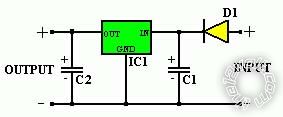
-------------
Be not guided by morality, but rather, integrity.
Posted By: oldspark
Date Posted: March 11, 2013 at 8:47 PM
Provided the load(s) have their rated supply voltage, they only take what current they can.
[ FYI - the water analogy. Voltage is pressure. Current is "quantity". If you have a small cup connected to the Hoover dam thru the dam wall by a pipe or straw, if their water levels are the same, it makes no difference how many litres or gallons either has, flow will only occur if the water levels vary.
If you increase your cup's voltage (water level) above the Hoover's, then your piddly little water (Amps) will fill the Hoover.
The moral being, it doesn't matter Hoo or how big you are, we can fill you. I mean...
Amps can't "push" into a circuit - it needs a voltage (difference) to do that. ]
Just think of headlights and small dash globes. That huge Amperage battery doesn't blow the little lights. That's because each light/load is designed for 12V. [Technically they have the correct resistance to limit the current to what they can handle. Ohm's Law V=IR (or I=V/R etc) refers.]
If you have capacity to spare (ie, output current), yes - that can be used to power other 5V loads.
As long as the total current required does not exceed the regulator's output spec. If it does, it may shutdown or be damaged, but it will certainly decrease its output voltage. (And it may get warm or hot when running near max load.)
And VU meters... I've seen some snazzy dual-meters thru eBay or google (google "vu meters" and select images) though I wondered if LED or other bargraph displays were better.
On one hand IMO there's nothing like a good classic VU meter. On the other hand, I like the timed "peak hold" function that some bargraphs have, and especially that their reds are easy to notice - even when not directly looking at them. (Maybe a meter with added yellow and/or red peak LEDs?
PS - This reply was for your 3rd last reply. I blame 2 telcons for my delay.
Posted By: oldspark
Date Posted: March 11, 2013 at 9:17 PM
Not the smaller versions...
Posted By: myonus
Date Posted: March 12, 2013 at 1:29 AM
oldspark wrote:
IC1 should be f.ex a 7805T (TO-220 package) that can handle up to 1A.
Not the smaller versions...
okie dokie, had to get the magnifying glass out. Ever since that night withe the shots of everclear...well these eyes jest don se so good.
wth?? who made these dardish things mini robots form Zargon!?
ok its a UA7805C (previous just a typo) and its definately a TO-220
looks like Texas Intruments logo and some other numbers 33A61H9
even if I have to buy a 2 dollar VR Im still gonna use this fancy heat sink the size of my .....ummm... thumb.
been working on the wiring of the Amp Rack. I feel like I acomplished absolutely nothing today o this. So Iz gonna have me a Fat Tire. And ponder the time I was light years away, makin sweet somthin to the ladies of Zargon.........
Until next time, Live long and wear a condom.
MYONUS
see down there, next to the bottle cap? Thar be a golden ticket (the heat sink of course)
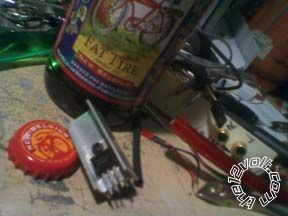
-------------
Be not guided by morality, but rather, integrity.
Posted By: oldspark
Date Posted: March 12, 2013 at 4:10 AM
I should have added that the power given off by the 7805 is the voltage across it times the current thru it.
Assume 15V in and (obviously) 5V out. (15V because most charging system are limited to ~14.4V maximum but can be higher at times, so we'll add a bit extra. Besides, 15 - 5 = 10, and 9 or 9.4 might require a calculator - though many of my friends & colleagues use a calculator to multiply by 10.)
So, 15V - 5V = 10V.
Current I = 900mA = 0.9A.
P = VI = 10V x .9A = 9 Watts.
I can't find the usual "simple" statement that the TO-220 will handle x-Watts at 25C etc. Instead I see the engineering formulae.
But the UA7805C is rated for 1.5A (intead of the norm of 1A), and they have internal thermal and current limiting.
Hence if they get too hot, they shouldn't self destruct - they'll drop their output current (and hence output voltage) instead.
I saw one example but that was only 500mA output (a bit over half your current) however it had a 21V input, hence about double your in/out voltage difference - ie, 8W - about the same as your power dissipation.
And that did not mention needing heatsink so I reckon you'll be okay. But cars may be hotter than that example's air temperature...
On te other hand, your 900mA may be a maximum input - eg, charging its battery, display lit, writing/recording etc.
But add your heatsink to be sure. It'll probably look cooler anyhow. (Ha ha, cooler...)
And a great thing with these regulators - the "tab" is connected to the common or 0V = GND terminal, hence it and its heatsink can touch grounded bodies & chassis etc. (Some inconsiderate regulators have their tabs or bodies connected to the input or output and hence it has to be electrically insulated from the heatsink etc or encased to prevent accidental shorts.)
BTW - if the output cap C2 is similar or bigger than the input's C1, add a diode that conducts from the output to the input. That will discharge C2 if its voltage ever exceeds the input voltage which can damage or destroy the volt reg.
It sounds like you'll do ok eh? Congrats!
Posted By: myonus
Date Posted: March 12, 2013 at 6:12 PM
oldspark wrote:
You shot Everclear? Hero!.......................................................
It sounds like you'll do ok eh? Congrats!
I wouldnt call it hero, hero is a couple months back finally having the will power to function without it. I had to take it easy for a while, so now i find comfort in a couple premium lagers when im stressed or when i need to celebrate or reward myself. Life is totally different. To me thats a hero my friend. But yea, everclear is pretty rott gut, but try Southern Georgia Moonshine, sip on that all night and it will not only prevent anything viral in your body to die, but it burns the cancer right out of your colon. Trust me I've frikkin seen it.
Now back to the regulators. This is going to take some time to processs. I get what your saying, which means i see the logic. My brain says the math right. but Im going to have to get on the design board and put it all together befor I can invision the way the signal is converted and its travel and destination. Im going to buy 6 VRs and some more heat sinks like this. and put them all in a small box so I can have future use available, maybe a couple of different voltages available. The circuts are small enough shouldnt take much room.
First step is to design the scematic. and before that focus on all that hydrographics you just wrote up there, and get out my scratch pad. I have plenty of patience, and I wanna do it right, and I want to learn somthing besides just soldering the ends together and crimping with my needle nose.
Im taking the night off the project, for now, ,,,so I say, but i'll probably be back to wiring up the amp rack tonite. Seems i have plenty of that to do, and i know wht im doing there. Its starting to look functional, have a few more parts coming. but a long way off from done.
So would you say a 1A diode across the cap? Im gonna ditch the VR that i have since i only have one. so Tonite maybe i will have a parts list ready and I can shoot that to ya and see what you think?

-------------
Be not guided by morality, but rather, integrity.
Posted By: oldspark
Date Posted: March 12, 2013 at 7:21 PM
EG - assume your load is 5W (5V @ 1A; P=VI). With 10V in, the VR drops another 5W as heat - ie, the 10V down to 5V (=5V) @ 1A.
If 15V in, that's a 10V drop x 1A = 10W.
IOW you are wasting 50% to ~66% as heat.
Apart from generating heat, it's a waste of electricity.
Hence the modern dc-dc converter which uses switching techniques (SMPS). They are more like transformers - ie, 15V @ 1A in for 5V @
3A out (15W in, 15W out) although in practice they are usually only up to 95% efficient but typically better than ~85%. (Hence only 15% to 5% wasted as heat.)
You might thus want to consider converters, and they'd normally be purchased complete. Current-Logic have several that might suit, and they are cheap - look at the lower "non-solated converter" section at current-logic dcdc_converter_all (search for "5V").
Just make sure any 12V input means "automotive 12V" - ie, operates with input voltages up to at least 16V, and below 12V - preferably own to 8V.
5V 10A converters as below are under $20.
PS - some dc-dc converters can be electrically noisy. Metal casing/shielding should prevent radiated noise. Capacitors across the output - usually around 0.01uF to 0.1uF - usually stop any conducted noise.
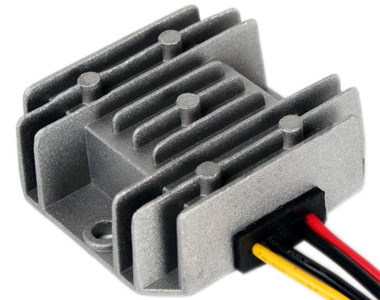
Posted By: myonus
Date Posted: March 12, 2013 at 11:06 PM
oldspark wrote:
Keep in mind that those "linear" VRs are inefficient. Whatever voltage they drop is given off as heat.
Just make sure any 12V input means "automotive 12V" - ie, operates with input voltages up to at least 16V, and below 12V - preferably own to 8V.
5V 10A converters as below are under $20.
PS - some dc-dc converters can be electrically noisy. Metal casing/shielding should prevent radiated noise. Capacitors across the output - usually around 0.01uF to 0.1uF - usually stop any conducted noise.
Hello, again, now im feeling like a pest. and a little frustrated. let me explain:
I went to ebay to start gathering some parts thinking this should be easy, then as i was looking at parts saw other parts then it just snowballed. Im pretty sure im over thinking this as I always do and sike myself out over nothing, so I gotta get a ground here. The primary goals of this voltage regulator:
DC auto 12 volt to DC 5volt 1A -*keep a fixed 5 volt constant -*with a heat sink to prevent overheating -*caps across outputs to prevent noise
then ultimately duplicate this 6X
could you look at this option? and i will look at your example now. If i can just get this pre-made to the specs i need, maybe spending a little extra isnt out of the question. Especially if the integrity of the circut is depending on my skills to choose the right components. (see this is me second guessing my ability)
i saw some others too, but thing is i get side tracked by all the other stuff that some of these products feature and really need to focus on what i need. Like I said maybe im overthinking this a bit, and getting gun shy.
-------------
Be not guided by morality, but rather, integrity.
Posted By: myonus
Date Posted: March 12, 2013 at 11:13 PM
yea that link didnt work, sorry
-------------
Be not guided by morality, but rather, integrity.
Posted By: myonus
Date Posted: March 12, 2013 at 11:15 PM
try this one
https://www./itm/DC-DC-Converter-Step-Down-voltage-Regulator-Module-/250888508121
-------------
Be not guided by morality, but rather, integrity.
Posted By: myonus
Date Posted: March 13, 2013 at 12:00 AM
Im guessing, that this one would be ideal, specifically says car audio etc
DC-DC Power Converter reducer 12V/24V Step down to 5V 3A 15W f Car Audio LED TV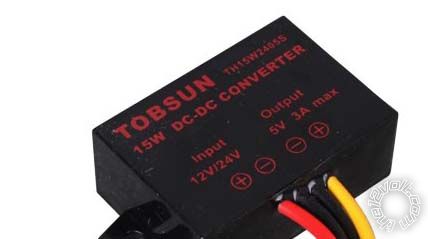
-------------
Be not guided by morality, but rather, integrity.
Posted By: oldspark
Date Posted: March 13, 2013 at 4:33 AM
I missed your 2 previous replies for some reason, but I think you may agree that getting a dc-dc converter is much easier (and probably cheaper) than making 6 "linear" circuits. Plus the efficiency bonus.
So, negating an notion of using linears...
There are lots of dc-dc conv products. As to how they perform, I don't know.
I like the looks of those Current-Logic alloy-cased units not only for their robustness, but more so because I reckon they should be well shielded (to prevent radiated noise). Price-wise I reckon they are cheap. I wouldn't hesitate to buy a spare (with any original order) even if it's never used (I'm a lover of redundancy - being able to replace or bypass faulty equipment anywhere and immediately).
Price is relative though. Prices for that sort of stuff is usually much cheaper stateside than it is here, so $20 for a 10A converter is nothing.
But those converters you found are cheaper still. I'd be concerned about plastic or no-cased converters, but common cig-plug converters for phone chargers, USB etc are plastic cased and they all use the same high-frequency switching (SMPS) and I don't know of any noisy ones - not that I use mobile digital radio nor TV etc. (GSM phone radiation is still the big problem lol.)
I do know the M2 & M4 PSUs are notoriously noisy, but they are for 12V PC applications (12V ATX supplies) and are irrelevant here.
So that uncased beast might be ideal for you. You can mount it in your hardware. And it might be cheap enough to buy a spare (assuming it works ok).
Posted By: myonus
Date Posted: March 13, 2013 at 6:35 PM
hello,
im going to move forward on these lil babys. they seem to be a solution, maybe not exactly, but close enough for now, I do like the ones above with the metal casings, but couldnt find it under 20 bucks with shipping. So, I choose this one EUR 2.32 each free shipping anywhere in the world. I got 3 for now, if the work for me fine, if not and i need to modify, fine, if that dont work I can attach it to a chain and hang it from my nipple ring; Im only out 6 - fity.
WTH? ..................... just kidding I would never hang anything from a nipple ring; except my attention.
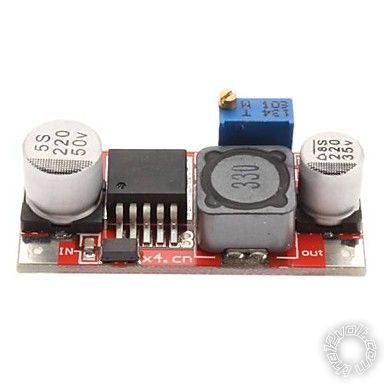
Heres the specs:
Input voltage: 4-40V
Output Voltage: 1.5-35V (adjustable)
Output current: rated current 2A, maximum 3A (need to add heat sink),
if the output power greater than 15W, the proposed combined heat sink
Conversion efficiency: Up to 92% (output voltage higher, the higher the efficiency)
Switching Frequency: 150KHz
Rectifier: Non-Synchronous Rectification
Module Properties: Non-isolated step-down module (buck)
Short circuit protection: current limiting, since the recovery
Operating temperature: Industrial grade (-40 ℃ to +85 ℃) (output power 10W or less)
Full load temperature rise: 40 ℃
Load regulation: ± 0.5%
Voltage regulation: ± 0.5%
Dynamic response speed: 5% 200uS
Size: 43 (L) * 20 (W) * 14 (H) mm (with potentiometer)
Output ripple:
Input 12V Output 5V 3A 60mV (MAX)
Input 24V Output 12V 3A 120mV (MAX)
-------------
Be not guided by morality, but rather, integrity.
Posted By: oldspark
Date Posted: March 13, 2013 at 7:03 PM
As long as people realise they are buck and don't lose their doe. (Puns, what puns?). IE, though the output is adjustable to 35V, they require the input voltage to exceed the output voltage.
That's irrelevant for you (ie, 12V in, 5V out is bucking fine), but as a caution to others (I think that Vin > Vout statement is on their page somewhere; it is not a buck-boost aka up or down converter.).
It's amazing how small packages can deliver relatively high currents (all thanks to high-frequency switching). Compare that module's size - or rather, that potted coil size - to a 50Hz or 60Hz 5V 2A transformer!